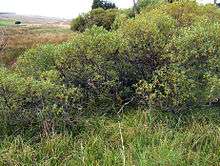Salix pentandra
| Salix pentandra | |
|---|---|
 | |
| Bay willow with early autumn colours, Kielder, Northumberland | |
| Scientific classification | |
| Kingdom: | Plantae |
| (unranked): | Angiosperms |
| (unranked): | Eudicots |
| (unranked): | Rosids |
| Order: | Malpighiales |
| Family: | Salicaceae |
| Genus: | Salix |
| Species: | S. pentandra |
| Binomial name | |
| Salix pentandra L. | |
Salix pentandra (bay willow) is a species of willow native to northern Europe and northern Asia.[1]
.jpg)
It is a large shrub or small tree growing to 14 m (46 ft) tall (rarely to 17 m), usually growing in wet, boggy ground. The leaves are glossy dark green, 5-12 cm long and 2-5 cm broad, with finely serrated margins. The dioecious flowers are catkins, produced in late spring after the leaves; the male catkins are yellow, 2-5 cm long, the female catkins greenish, 1.5-3 cm long; they are pollinated by bees. The fruit is a small capsule containing numerous minute seeds embedded in white down which aids wind dispersal.[1][2]
The scientific name refers to the male flowers having five stamens. The English name derives from the resemblance of the leaves to those of the bay laurel; other common names include bay-leaved willow and laurel willow. Its glossy leaves make it more decorative than many other willows, so it is often planted as an ornamental tree.[1]
It has become locally naturalised in northern North America, and is known as laurel willow there.[3]
References
- 1 2 3 Rushforth, K. (1999). Trees of Britain and Europe. Collins ISBN 0-00-220013-9.
- ↑ Mitchell, A. F. (1974). A Field Guide to the Trees of Britain and Northern Europe. Collins ISBN 0-00-212035-6
- ↑ "Salix pentandra". Natural Resources Conservation Service PLANTS Database. USDA. Retrieved 27 October 2015.
| Wikimedia Commons has media related to Salix pentandra. |